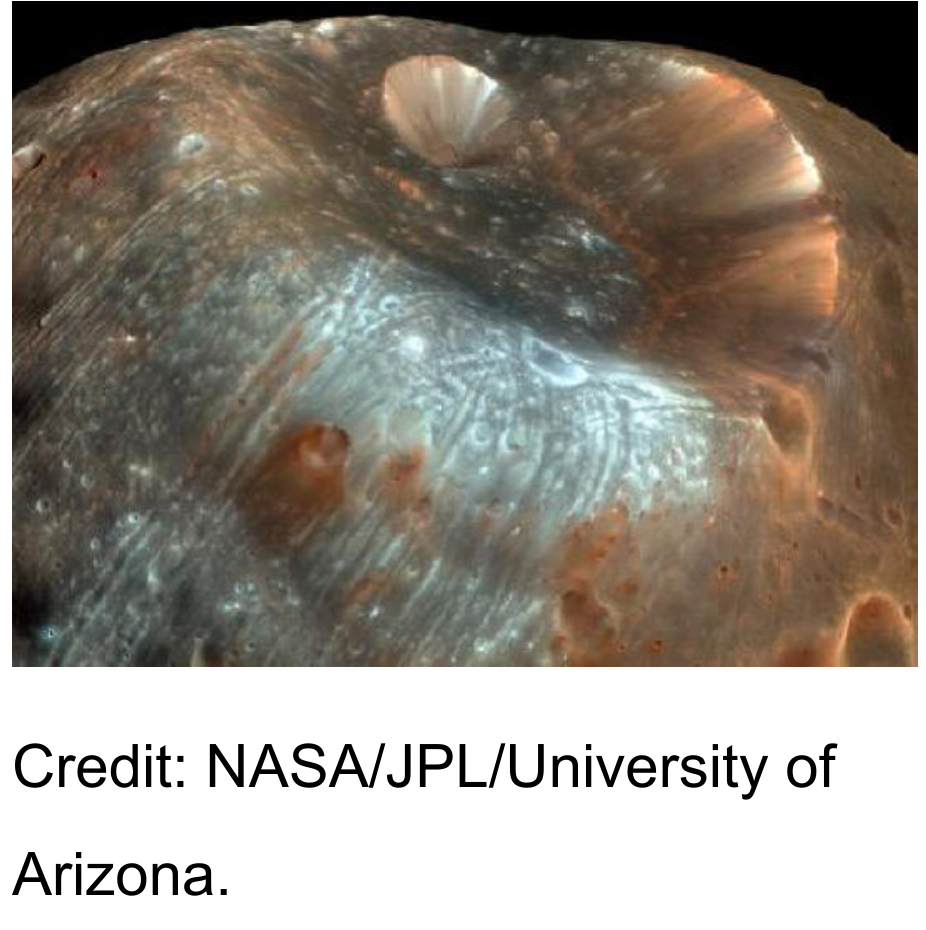ザ・サンダーボルツ勝手連 [Is Stickney Crater an Impact Feature? スティックニー・クレーターは衝突の特徴ですか?]
[Is Stickney Crater an Impact Feature? スティックニー・クレーターは衝突の特徴ですか?]

HiRISE image of Stickney Crater on Phobos.
フォボスのスティックニー・クレーターのHiRISE画像。
〈https://hirise.lpl.arizona.edu/phobos.php〉
――――――――
Apr 14, 2008
スティックニー・クレーターは、フォボス自体の直径のほぼ半分です。 なぜ衝突はこの小さな月衛生を粉砕しなかったのですか?
上のカラー写真は、3次元のアスペクトを与えるために約10分間隔で撮影された2枚の写真を合成したものです。
最近の「今日の写真」は、フォボスの大規模な地層のいくつか、特にスティックニー・クレーターについて説明しています、しかし、最近利用可能になったこのより劇的な画像は、放電加工(EDM)イベントの独特な特徴をより明確に描写しているため、別の表示に値します。
リムの小さい、後のクレーターは特別な注意に値します。
これは、放電イベントで見られると予想されるパターンです、プラズマボルト(プラズマ電激)からの最初のストライクが最もエネルギーが高く、その後、放電が小さいほど、より高い(地形の)特徴が優先的にストライクされるためです―
リム(縁)。
リムの内側の途中をクレーターをきれいに加工することは、EDMのもう1つの際立った特徴です。
この特徴はどのように衝突の一部になることができますか?
フォボスの画像は、目立つ縞と溝を示しており、そのうちのいくつかはスティックニー・クレーターの縁を越えて走っています。
〈https://static.uahirise.org/images/2008/details/phobos/PSP_007769_9010_IRB.jpg〉
〈https://static.uahirise.org/images/2008/details/phobos/PSP_007769_9010_IRB_Stickney.jpg〉
これらは、この種のEDMイベントに期待される特徴でもあります。
それらのいくつかは放射状ではない方向にあり、いくつかはコース変更があり、それは質問につながります:
「これらの2つの現象は、衝突イベントで予想されるでしょうか?」
縞模様と溝については、2008年4月8日の「天文学、今日の写真」は次のように述べています、小惑星のようなフォボスの表面重力は地球の重力の1/1000未満ですが、縞模様は、緩い物質が時間の経過とともにクレーター壁の内側に滑り落ちたことを示唆しています…。
表面に沿った奇妙な溝の起源は不思議ですが、クレーター形成の衝突に関係している可能性があります。」
しかし、同じ質問が残っています:
「これは衝突イベントの兆候ですか?」
EDMイベントでは、隕石が地表に衝突したことを示すのではなく、風景に点在する他の多くのピットや小さなクレーターが予想されます。
電気的宇宙仮説で想定された惑星間放電のシナリオでは、フォボスはクロスファイアに巻き込まれて逃げることはほとんどできなかったでしょう。
スティックニー・クレーターは、エロスやマチルデ、月衛星のミマスやテティスなど、他の同等のサイズの小惑星のものを反映しています。〈https://takaakifukatsu.hatenablog.jp/entry/2021/07/14/184811〉
〈https://news.cornell.edu/〉
〈https://takaakifukatsu.hatenablog.jp/entry/2020/05/12/194226〉
〈https://takaakifukatsu.hatenablog.jp/entry/2021/10/05/101332〉
Contributed by Michael Armstrong
マイケル・アームストロングによる寄稿
――――――――
Apr 14, 2008
Stickney crater is almost half the diameter of Phobos itself. Why did the impact not shatter this small moon?
スティックニー・クレーターは、フォボス自体の直径のほぼ半分です。 なぜ衝突はこの小さな月衛生を粉砕しなかったのですか?
The color picture above is a composite from two pictures taken about 10 minutes apart in order to give the 3-dimensional aspect.
上のカラー写真は、3次元のアスペクトを与えるために約10分間隔で撮影された2枚の写真を合成したものです。
A recent Picture of the Day described some of the large-scale formations on Phobos, especially Stickney Crater, but this more dramatic picture, which has recently become available, deserves another showing because it portrays the distinctive features of an Electric Discharge Machining (EDM) event with greater clarity.
最近の「今日の写真」は、フォボスの大規模な地層のいくつか、特にスティックニー・クレーターについて説明しています、しかし、最近利用可能になったこのより劇的な画像は、放電加工(EDM)イベントの独特な特徴をより明確に描写しているため、別の表示に値します。
The smaller, later craters on the rim deserve special attention.
リムの小さい、後のクレーターは特別な注意に値します。
This is the pattern that one would expect to see in a discharge event, since the initial strike from the plasma bolt would be the most energetic and later, smaller discharges would preferentially strike the higher feature—
the rim.
これは、放電イベントで見られると予想されるパターンです、プラズマボルト(プラズマ電激)からの最初のストライクが最もエネルギーが高く、その後、放電が小さいほど、より高い(地形の)特徴が優先的にストライクされるためです―
リム(縁)。
The clean machining of the crater part way up on the inside of the rim is another distinguishing mark of EDM.
リムの内側の途中をクレーターをきれいに加工することは、EDMのもう1つの際立った特徴です。
How can this feature be part of an impact?
この特徴はどのように衝突の一部になることができますか?
Images of Phobos reveal prominent streaks and grooves, some of which are running up and over the rim of Stickney Crater.
フォボスの画像は、目立つ縞と溝を示しており、そのうちのいくつかはスティックニー・クレーターの縁を越えて走っています。
〈https://static.uahirise.org/images/2008/details/phobos/PSP_007769_9010_IRB.jpg〉
〈https://static.uahirise.org/images/2008/details/phobos/PSP_007769_9010_IRB_Stickney.jpg〉
These also are features expected from this kind of EDM event.
これらは、この種のEDMイベントに期待される特徴でもあります。
Some of them are in directions that are not radial and some have course changes, which leads to the question:
“Would these two phenomena ever be expected in an impact event?”
それらのいくつかは放射状ではない方向にあり、いくつかはコース変更があり、それは質問につながります:
「これらの2つの現象は、衝突イベントで予想されるでしょうか?」
As to the streaks and grooves, The Astronomy Picture of the Day for April 08, 2008, says, ” Even though the surface gravity of asteroid-like Phobos is less than 1/1000th Earth's gravity, streaks suggest loose material has slid down inside the crater walls over time….
縞模様と溝については、2008年4月8日の「天文学、今日の写真」は次のように述べています、小惑星のようなフォボスの表面重力は地球の重力の1/1000未満ですが、縞模様は、緩い物質が時間の経過とともにクレーター壁の内側に滑り落ちたことを示唆しています…。
The origin of the curious grooves along the surface is mysterious but may be related to the crater-forming impact.”
表面に沿った奇妙な溝の起源は不思議ですが、クレーター形成の衝突に関係している可能性があります。」
But the same question remains:
“Is this the sign of an impact event?”
しかし、同じ質問が残っています:
「これは衝突イベントの兆候ですか?」
Rather than being indicative of a meteor crashing into the surface, the many other pits and small craters that dot the landscape are to be expected in an EDM event.
EDMイベントでは、隕石が地表に衝突したことを示すのではなく、風景に点在する他の多くのピットや小さなクレーターが予想されます。
In the scenario of interplanetary discharges envisioned in the Electric Universe hypothesis, Phobos could hardly have escaped being caught in the crossfire.
電気的宇宙仮説で想定された惑星間放電のシナリオでは、フォボスはクロスファイアに巻き込まれて逃げることはほとんどできなかったでしょう。
Stickney Crater mirrors those on other comparably sized asteroids such as Eros and Mathilde, as well as the moons Mimas and Tethys.
スティックニー・クレーターは、エロスやマチルデ、月衛星のミマスやテティスなど、他の同等のサイズの小惑星のものを反映しています。〈https://takaakifukatsu.hatenablog.jp/entry/2021/07/14/184811〉
〈https://news.cornell.edu/〉
〈https://takaakifukatsu.hatenablog.jp/entry/2020/05/12/194226〉
〈https://takaakifukatsu.hatenablog.jp/entry/2021/10/05/101332〉
Contributed by Michael Armstrong
マイケル・アームストロングによる寄稿